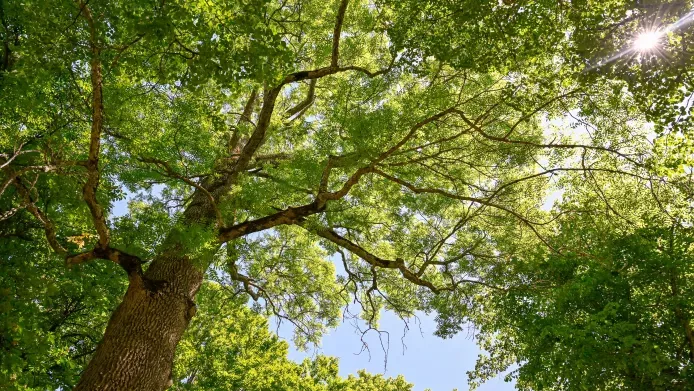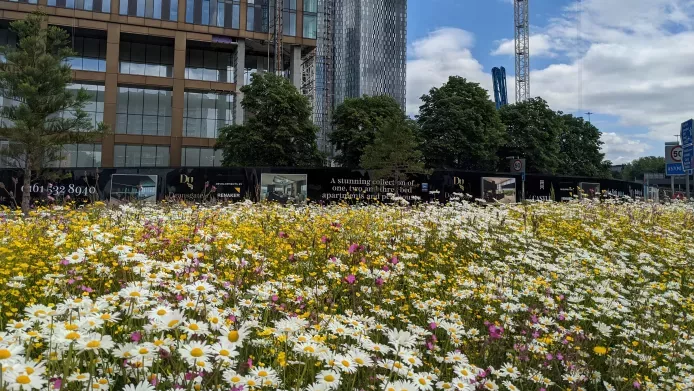Cities are often places of extreme social inequality and environmental injustice. How can we create biodiverse cities that provide equitable access to nature, and reduce environmental burdens for marginalised communities?
The urban environment: preconceptions
The dominant view of cities for a long time has been that they are predominantly human spaces, ‘concrete jungles’ unwelcome to non-human life apart from the occasional tree or rodent. Cities in Western societies are usually thought of as places where humans are innately separate from animals and nature. Urban infrastructure and construction has pushed nature out of habitats where they once thrived, creating devastating impacts for worldwide biodiversity and species extinction.
What if the phrase ‘concrete jungle’ could take on a new meaning? A jungle that plants, insects, birds, fungi, animals, and humans all share.
 iStock credit: Amy Sparwasser
iStock credit: Amy Sparwasser
Biodiversity and climate resilient cities
New research has established that despite the environmental destruction cities have caused, they could be the answer to environmental resilience for the future.
Cities can host a diverse range of habitats from parks and community gardens to green roofs and balconies. These spaces provide crucial support for pollinators, birds, and small animals. Combined, they can create green pathways for wildlife to safely navigate urban landscapes. Cities may be able to support greater biodiversity levels than other locations, such as industrial agricultural areas with little potential for growing and encouraging wildlife.
There are also numerous opportunities to support threatened native species in urban environments, as there is often less growing competition compared to rural areas.
Managed in the right way, urban nature has invaluable benefits such as:
- reducing effects of ‘urban heat islands’
- reducing flooding and drought
- providing clean air and water
- enhancing beauty of neighbourhoods
- improving public health and wellbeing
For example, rain gardens can soak up storm water to reduce flooding, and trees provide shade which counteracts the urban heat island effect.

Urbanisation is thought to have weakened people’s nature connectedness, contributing to an increase in mental health conditions - the biggest single cause of disability in the UK (Department of Health and Social Care).
Improving biodiversity in urban areas can help connect people to their natural environments and improve health and wellbeing.
Championing Environmental Justice
Unfortunately, not everyone in cities enjoys equal access to nature. People from low-income areas, ethnic minority backgrounds and disabled people are among the groups most likely to miss out on the full benefits of urban nature, due to marginalisation and underrepresentation. These issues frequently extend to environmental decision-making processes.
Environmental justice recognises that some people are unjustly and disproportionately affected by climate change and environmental impacts such as pollution and poor air quality. It promotes including marginalised communities in environmental decision making, and the right of all people to equal access to a healthy, safe, and sustainable environment.
Equitable access to green spaces

'Air pollution is the single biggest environmental threat to health in the UK, shortening tens of thousands of lives each year'.
The Woodland Trust and other partners recently unveiled an online map showing urban tree cover disparities across the UK.
Their Tree Equity Score tool has proven that less affluent neighbourhoods, including those with high populations of minority ethnic groups, have less tree canopy per person, more air pollution, and higher temperatures than more affluent neighbourhoods.
Join the movement!
Transforming cities into havens for biodiversity and champions of environmental justice requires effort and unity between policymakers, planners, scientists, community groups, and residents.
Advocate for green spaces in your community by getting involved with local growing projects that support urban trees and wildlife, such as planting and citizen science projects.
Grow Wild projects supporting urban biodiversity
Love Heaton Norris - Stockport
As part of the Grow Wild Community Programme 2023, Love Heaton Norris created a scrape (a shallow pool that seasonally holds water ), filled with UK native aquatic and bog plants.
The scrape enables the the space to support more types of plants and wildlife that require freshwater to survive, increasing biodiversity on the site.
View before and after images below:


Conquer Life CIC - Bootle
Conquer Life CIC transformed a fly tipping area into an urban garden at their community centre, whilst part of Grow Wild's Community Programme 2022.
In addition to creating a safe and accessible garden people, they also considered what wildlife needed in the space. To support solitary bees living on the site, concrete areas where bees had been sheltering were retained to minimally impact the pollinators vital to supporting plant growth in the garden.
View before and after images below:


Learn more about urban biodiversity


CPRE, The Countryside Charity. A research overview: Access to nature in the English countryside, 2021. Available from: https://www.cpre.org.uk/resources/2021-research-overview-access-to-nature-in-the-english-countryside/
Environment Agency. (2022) The Children’s People and Nature Survey for England: Summer Holidays 2021 (Official Statistics). Available from: https://www.gov.uk/government/statistics/the-childrens-people-and-nature-survey-for-england-summer-holidays-2021-official-statistics/the-childrens-people-and-nature-survey-for-england-summer-holidays-2021-official-statistics
Environment Agency. (2023). State of the environment: health, people and the environment. Available from: https://www.gov.uk/government/publications/state-of-the-environment/state-of-the-environment-health-people-and-the-environment
Groundwork.(2021) Out of Bounds: Equity in Access to Urban Nature. Available at: https://www.groundwork.org.uk/about-groundwork/reports/outofbounds/
Lambert, Max, and Christopher Schell (eds). (2023). Urban Biodiversity and Equity: Justice-Centered Conservation in Cities. Oxford Academic. doi: https://doi.org/10.1093/oso/9780198877271.001.0001, accessed 14 Feb. 2024.
The Health Foundation. (2020). Health Equity in England: The Marmot Review 10 Years On. Available from: https://www.health.org.uk/publications/reports/the-marmot-review-10-years-on

